Spike width reduction modifies the dynamics of short-term depression at a central synapse in the locust
- PMID: 12930784
- PMCID: PMC6740751
- DOI: 10.1523/JNEUROSCI.23-20-07461.2003
Spike width reduction modifies the dynamics of short-term depression at a central synapse in the locust
Abstract
Short-term synaptic depression is an important component of computation within neural networks, but little is known of its contribution to information processing during synaptically generated spike trains. We analyzed short-term synaptic depression at a synapse between two identified motoneurons innervating the hind leg of the locust: the FETi-FlTi synapse (fast extensor tibiae-flexor tibiae). Brief electrical stimulation of a single hind leg proprioceptor, the lump receptor (LR), led to prolonged sequences of spikes in FETi, similar in number and frequency to those during natural kicking movements. Depression at the FETi-FlTi synapse during LR-evoked spike bursts was compared quantitatively to that during antidromic spike trains evoked by electrical stimulation of FETi in the extensor tibiae muscle, and by modeling. The magnitude of the short-term depression was significantly greater during LR-evoked spike trains. On the basis of the model parameters required to fit the depression, the FETi-FlTi synapse is predominantly used for transmitting the timing of the onset of FETi spiking rather than its spike rate. During LR-evoked spike trains, there was a rapid reduction in presynaptic spike width that did not occur during antidromic spike trains under physiological calcium concentrations. This produced a concomitant reduction in the amplitude of the FlTi EPSP, suggesting that it contributed to the differences between the two stimulation regimes. Differences in the short-term depression between synaptically evoked and antidromic spike trains emphasize that the properties of synaptic information transfer are dependent on the in vivo conditions at the synapse and may not be reproduced by in vitro spike trains.
Figures


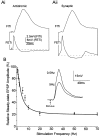
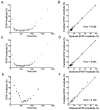

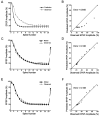
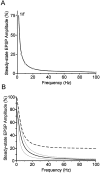

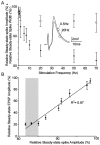

Similar articles
-
Matched Short-Term Depression and Recovery Encodes Interspike Interval at a Central Synapse.Sci Rep. 2018 Sep 11;8(1):13629. doi: 10.1038/s41598-018-31996-0. Sci Rep. 2018. PMID: 30206296 Free PMC article.
-
Depression of synaptic connections between identified motor neurons in the locust.J Neurophysiol. 1995 Aug;74(2):529-38. doi: 10.1152/jn.1995.74.2.529. J Neurophysiol. 1995. PMID: 7472360
-
Dynamics of neurons controlling movements of a locust hind leg. III. Extensor tibiae motor neurons.J Neurophysiol. 1997 Jun;77(6):3297-310. doi: 10.1152/jn.1997.77.6.3297. J Neurophysiol. 1997. PMID: 9212276
-
Physiological and Ultrastructural Characterization of a Central Synaptic Connection between Identified Motor Neurons in the Locust.Eur J Neurosci. 1989 Mar;1(2):111-126. doi: 10.1111/j.1460-9568.1989.tb00778.x. Eur J Neurosci. 1989. PMID: 12106160
-
Synaptic mechanisms and circuitry involved in motoneuron control during sleep.Int Rev Neurobiol. 1983;24:213-58. doi: 10.1016/s0074-7742(08)60223-8. Int Rev Neurobiol. 1983. PMID: 6197386 Review.
Cited by
-
Consequences of converting graded to action potentials upon neural information coding and energy efficiency.PLoS Comput Biol. 2014 Jan;10(1):e1003439. doi: 10.1371/journal.pcbi.1003439. Epub 2014 Jan 23. PLoS Comput Biol. 2014. PMID: 24465197 Free PMC article.
-
Long-term sensitization training produces spike narrowing in Aplysia sensory neurons.J Neurosci. 2007 Jan 17;27(3):676-83. doi: 10.1523/JNEUROSCI.4025-06.2007. J Neurosci. 2007. PMID: 17234599 Free PMC article.
-
Matched Short-Term Depression and Recovery Encodes Interspike Interval at a Central Synapse.Sci Rep. 2018 Sep 11;8(1):13629. doi: 10.1038/s41598-018-31996-0. Sci Rep. 2018. PMID: 30206296 Free PMC article.
-
Serotonergic enhancement of a 4-AP-sensitive current mediates the synaptic depression phase of spike timing-dependent neuromodulation.J Neurosci. 2006 Feb 15;26(7):2010-21. doi: 10.1523/JNEUROSCI.2599-05.2006. J Neurosci. 2006. PMID: 16481434 Free PMC article.
-
Compensatory plasticity at an identified synapse tunes a visuomotor pathway.J Neurosci. 2007 Apr 25;27(17):4621-33. doi: 10.1523/JNEUROSCI.4615-06.2007. J Neurosci. 2007. PMID: 17460075 Free PMC article.
References
-
- Abbott LF, Sen K, Varela JA, Nelson SB ( 1997) Synaptic depression and cortical gain control. Science 275: 220-222. - PubMed
-
- Burns MD, Usherwood PNR ( 1979) The control of walking in Orthoptera. II. Motor neurone activity in normal free-walking animals. J Exp Biol 79: 69-98.
-
- Burrows M ( 1995) Motor patterns during kicking movements in the locust. J Comp Physiol [A] 176: 289-305. - PubMed
-
- Burrows M ( 1996) The neurobiology of an insect brain, p 682. Oxford: Oxford University.
Publication types
MeSH terms
LinkOut - more resources
Full Text Sources
